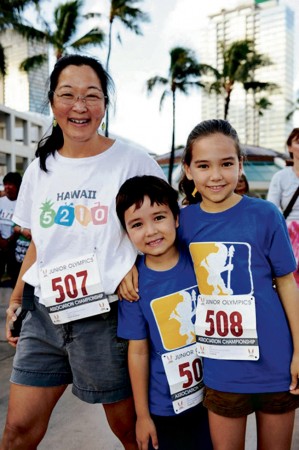Patter Of Little Feet A Healthy Sound
The Hawaii 5210 Keiki Run presented by Kaiser Permanente takes place Saturday, Feb. 16, with more than 1,300 children, parents and classmates going on a 1.5-mile untimed race around the Neal Blaisdell Center Exhibition Hall.
The event not only provides an opportunity for families to get out and be active, but it also gives back 100 percent of the entry fee to participating schools to support their P.E., physical activity and nutrition education programs. Last year’s event raised more than $29,000, with Sacred Hearts Academy having the highest number of participants.
Founded in 2011, Hawaii 5210 “Let’s Go!” is an initiative to promote healthy eating and active living, and to prevent childhood obesity in Hawaii through a coordinated, collaborative, locally relevant health education campaign. The program is based at the University of Hawaii John A. Burns School of Medicine Department of Pediatrics and led by HICORE, Hawaii Initiative for Childhood Obesity and Research and Education.
The numbers 5210 represent the daily recommendations of five fruits, roots and vegetables; (a limit of) two hours of screen time; one hour of physical play; and zero sugary drinks.
“We know that change is not easy and encourage parents, children, families to take one step at a time and small changes that will stick,” says Dr. May Okihiro, a pediatrician at Waianae Coast Comprehensive Health Center and HICORE director. “(For example), serve and drink more water, buy less soda, eat at home one more day of the week, cook less rice, walk after dinner one day of the week.
“None of us is perfect and we know it’s very hard, but small change can happen.”
According to Okihiro, pediatricians are continuing to notice a trend in rising obesity rates and severity in their clinical practices, and the development now of pre-diabetes and type 2 diabetes in kids and adolescents.
“Locally, it’s a big problem that’s getting worse,” she adds. “It’s been (a problem) nationally and locally for about the last 30 years. It used to be 5-10 percent of the kids were overweight or obese. Now, it’s 30-50 percent, depending on the age group and community.
“We see it more in communities that are economically disadvantaged, and we see it more in some ethnic groups, but it’s been rising across all groups.”
She believes the rise comes from a complex array of factors having to do with how we live our lives.
“Most families now have both parents working, and so we’re eating out much more,” she says. “Kids don’t play outside as much, life is structured in a much different way, and all of that has impacted what we eat, how we eat and how we move.”
As a mother of two children – 10-year-old Mariko and 8-year-old Michael – Okihiro says she tries to make a conscious effort to plan their meals and cook at home. She also tries to have more fruits and vegetables in the kitchen.
“It’s not that my kids don’t have any treats, they don’t have it all the time,” she says. “In general, we serve them water and milk, so that’s what they ask for and it’s become a habit.
“Sugary drinks are the No. 1 source of calories in our kids’ diet. We know that it adds to excess weight gain and tooth decay, and that when all of us have sugary drinks we don’t compensate by decreasing the amount of calories in what we eat, so it tends to be excess calories that make excess weight gain very easy.
“Juice also has been heavily promoted (as a healthy option), but a lot of juice drinks have small amounts of real fruit juice and a lot of added sugar, chemicals and flavoring. Even 100 percent fruit juice has a lot of sugar in the form of fruit sugars, and add a lot of excess calories and sugar to the diet that we don’t need.”
The change for a healthy lifestyle needs to start at the family level, but it’s also important at the community level (such as at schools) to address the many factors that push us to overeat and not move.
Entry deadline for the keiki run has passed, but late entries may be put on a waiting list through Ho’omiki, which is organizing the event. For inquires, email tonimuranaka@gmail.com.






